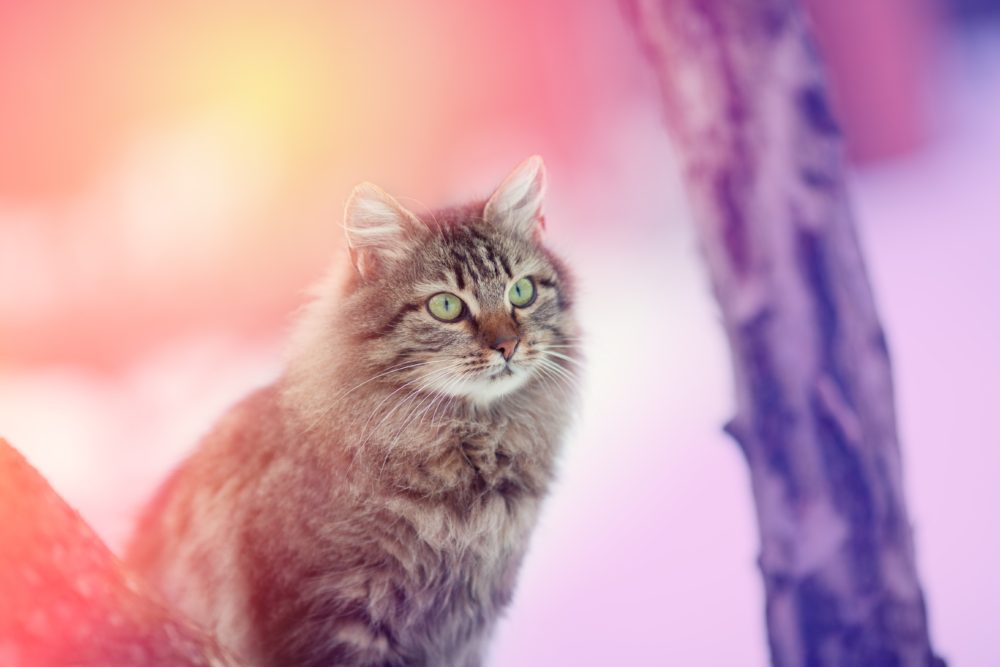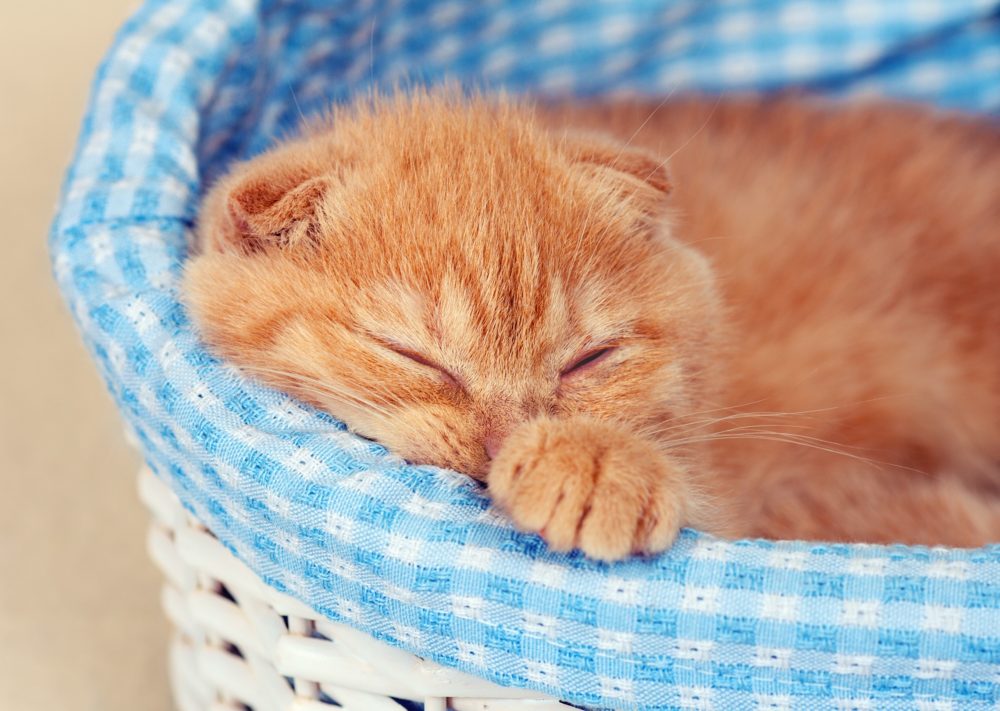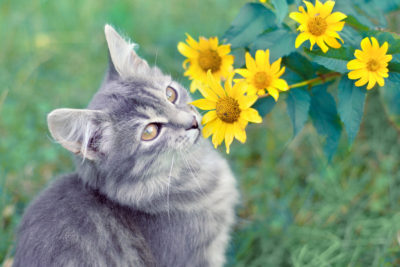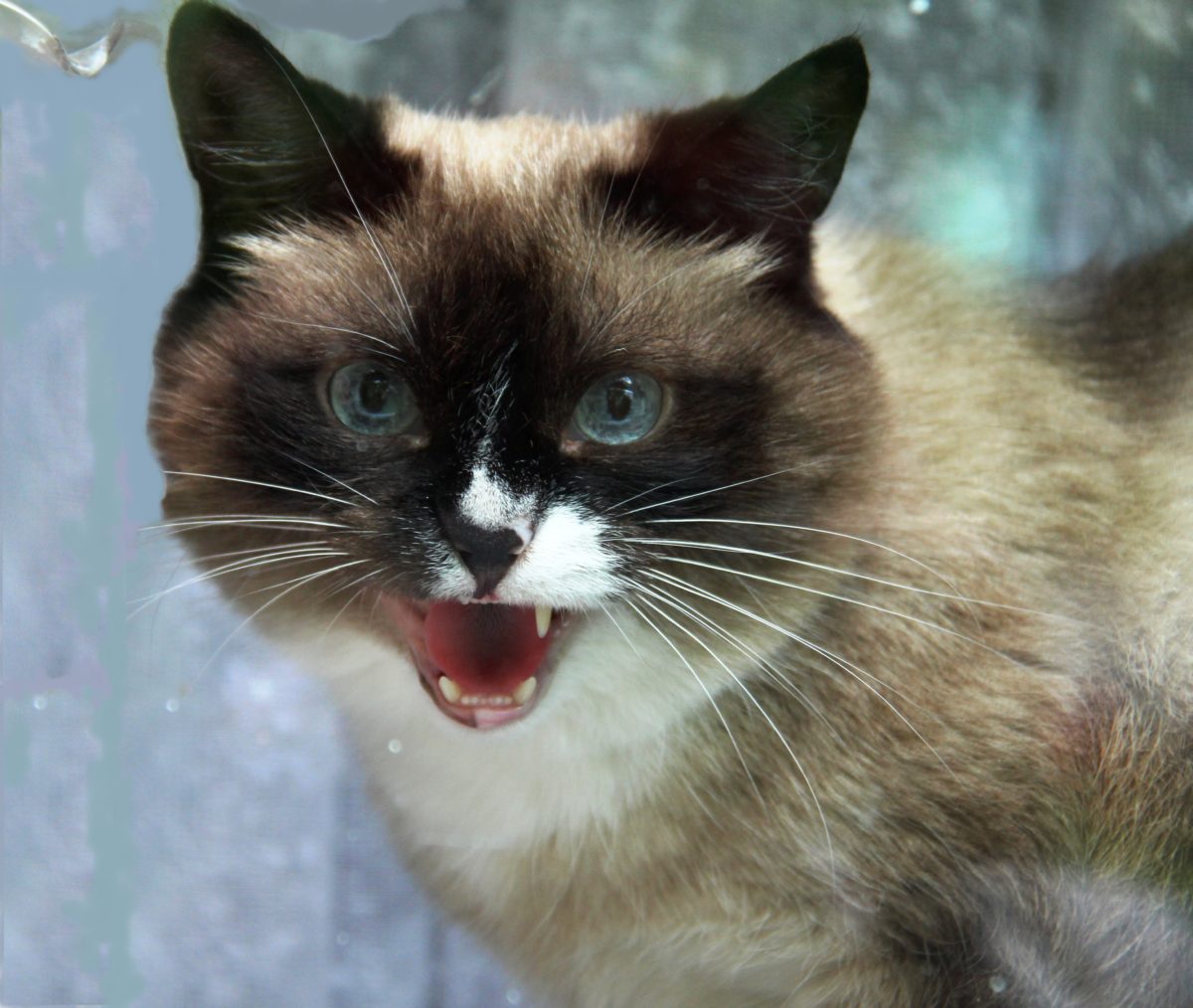
Why do cats meow? Cat communication – a complete guide
Have you ever wondered what your cat is trying to tell you? Ever wondered how they communicate with each other? Cats are excellent at expressing their feelings and communicating their emotions very clearly to each other, and to humans.
Cats communicate in a variety of different way, and using a mixture of the following senses, including;
- vocally,
- visually,
- in tactile ways and
- via scent.
It is important to remember though that each cat is different, and each may slightly vary in their communication methods. But being aware of these main pointers and observing your cat to understand your cat’s own communication habits and quirks will only strengthen the bond between you both. It will also help to prevent misunderstandings and potential aggression. Cat language is a combination of tail position, facial expression, vocal and scenting messages. Looking out for certain pointers and clues can reveal many things that your cat may be trying to communicate.
How do cats communicate vocally?
Cats have a wide range of vocal communication and are said to have the widest range of all the carnivore species. This is thought to be because, naturally, cats are most active at dusk onwards when light is poor and so vocalisation is key for communicating. Cats use vocal communication for interactions between mother and kittens, for mating and sexual relations, for defence and safety, and for human interaction. There are 7 main ways a cat can communicate vocally:
- Purring
- Meowing
- Chirping and chattering
- Calling
- Growling, hissing and snarling
- Howling, yowling, moaning and wailing
- Ultrasonic
Purring
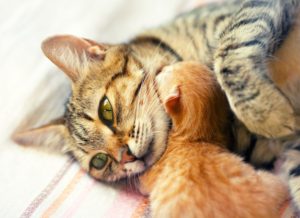 Cats can start to purr from as young as two days old. Purring is a soft, vibrating noise and usually expressed when happy and content, but cats also purr when experiencing trauma or pain such as during labour or when in pain. Kittens often purr when they are being nursed as a sign of being content and the mother may also purr in return to reassure the kittens. Purring may also be a comfort seeking vocalisation when recovering from an illness or when close to the end of their days. Is it thought purring is like an internal massage to your cat and promotes healing.
Cats can start to purr from as young as two days old. Purring is a soft, vibrating noise and usually expressed when happy and content, but cats also purr when experiencing trauma or pain such as during labour or when in pain. Kittens often purr when they are being nursed as a sign of being content and the mother may also purr in return to reassure the kittens. Purring may also be a comfort seeking vocalisation when recovering from an illness or when close to the end of their days. Is it thought purring is like an internal massage to your cat and promotes healing.
Meowing
Meowing is the communication method used by kittens to seek attention from their mother. Because kittens are born blind and deaf, meowing is their method of alerting their mother that the need attention. Interestingly by four to five months kittens stop meowing altogether. Adult cats very rarely communicate with each other by meow. In fact, meowing is more of a method of seeking attention from people in order to have their needs met! Cats will learn to make demands of us humans by observing to which of their sounds that we respond to best. The meow can represent feelings ranging from friendly and welcoming to demanding and attention seeking, or assertiveness and complaining. The way we respond to our cats can play a vital role in how vocal they are. If meowing is met with a positive response such as food or attention, then they are more likely to repeat this behaviour in the future. Excessive meowing may be a sign of pain, thirst, hunger or discomfort. Therefore, if your cat is meowing, he is probably trying to tell you something.
It can also be that some cats are merely more vocal than others, due to different personalities and due to different breeds. For example, Siamese cats are generally quite a vocal breed and they seem to have a persistent and distinctive meow where as the Russian blue breed is a much quieter breed which seems to match its shy and gentle characteristics.
Chirping and chattering
Mother cat mainly uses the chirring noise to call her kittens. Kittens will recognise their own mother’s chirring call. It sounds very similar to meowing but more rolled on the tongue. Cats will also use this form of communication to entice the friendly approach of another cat or human.
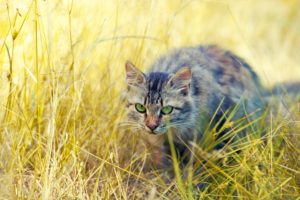 When hunting prey, cats sometimes make a chirping or chattering noise which can be excitable and sustained. Cats who are tracking prey can also make a distinctive clacking sound. Most cat experts believe the chattering noise is down to the cat practicing the special biting technique it uses to kill its prey. When a cat is killing its prey, they bite down into the animal’s neck, then using a vibrational action similar to a saw to bite through the spine. The sound of this killing bite is a chattering noise and is it believed that when they are observing their prey, cats will practice this chattering jaw movement.
When hunting prey, cats sometimes make a chirping or chattering noise which can be excitable and sustained. Cats who are tracking prey can also make a distinctive clacking sound. Most cat experts believe the chattering noise is down to the cat practicing the special biting technique it uses to kill its prey. When a cat is killing its prey, they bite down into the animal’s neck, then using a vibrational action similar to a saw to bite through the spine. The sound of this killing bite is a chattering noise and is it believed that when they are observing their prey, cats will practice this chattering jaw movement.
Calling
A cat’s call will usually be a loud rhythmic noise made with the mouth closed. It is mainly used when female cats seek a male or when males are fighting each other.
Growling, hissing and snarling
Growling, hissing and snarling are all noises a cat will make when threat is perceived. This communication can be towards another cat or other species and is usually accompanied with a postural display to ward off the threat. Young kittens will hiss and spit when first handled by a human. Older cats will hiss and spit when scared or angry. Hissing is usually the next stage of warning after growling.
Howling, yowling, moaning and wailing
When a cat is feeling threatened, a howl, yowl, moan or wail will be communicated vocally. Cats may howl when feeling bored, anxious or stressed. If they don’t have enough mental stimulation or left alone often for long periods this will lead to boredom and frustration. At certain times of the year, when cats are seeking to mate, once again they can become very vocal.
Ultrasonic
Ultrasonic, or high frequency communication is usually used by kittens to communicate.
How do cats communicate visually?
As well as vocalisation, cats use posture and movement to communicate their emotions and information. A change in a cat’s facial feature can be one of the best indicators of communication. It is important not to look at one feature in isolation. Observing the body language as a whole rather than focussing on just one area, will give a much clearer indicator of how your cat is feeling.
There are 4 main ways a cat will communicate visually:
- Posture
- Ears
- Eyes
- Tail
Posture
A calm cat will stand relaxed with a still tail.
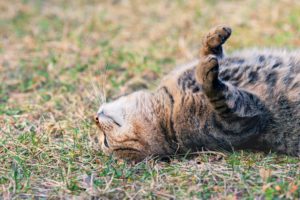 A cat lying on her back with belly exposed is in a position of vulnerability thus communicating trust and comfort or simply enjoying a little warm sun on their belly. There are occasions when a cat will use this position of rolling onto its back to defend and escape especially if felling cornered and will be swiftly followed with extended claws and show of teeth.
A cat lying on her back with belly exposed is in a position of vulnerability thus communicating trust and comfort or simply enjoying a little warm sun on their belly. There are occasions when a cat will use this position of rolling onto its back to defend and escape especially if felling cornered and will be swiftly followed with extended claws and show of teeth.
Aggression will change the cat’s posture to include an elevated rump, back legs stiffened, nose forward, ears back and tail hairs erected. This posture is a signal to beware and not to approach.
It is also worth noting that physical distance is a great indicator by your cat whether or not they desire affection and attention at a point in time. Maintaining a good distance between you can quite simply mean they are happy where they are and have no wish to play or interact at this time. If your cat approaches you, coming close to you it means they are quite happy to make contact and interact.
Ears
A cat’s ears are very flexible, they can move up and down and turn through 180 degrees. A standard position for a cats ears is pointing forwards and slightly outward, this denotes a relaxed cat.
 A vigilant and focused cat will have straight vertical ears and the ears may swivel towards the noise it has just heard. Ears that are totally flattened against the head denote a frightened cat, this is a defensive position to protect its ears from a fight or injury. An aggressive cat will swivel its ears sideways so the backs are visible and a signal to denote it is ready for attack.
A vigilant and focused cat will have straight vertical ears and the ears may swivel towards the noise it has just heard. Ears that are totally flattened against the head denote a frightened cat, this is a defensive position to protect its ears from a fight or injury. An aggressive cat will swivel its ears sideways so the backs are visible and a signal to denote it is ready for attack.
Eyes
A calm, contented cat will communicate this emotion to humans, and to other cats, by a slow blink. Lowering their eyelids or blinking slowly is a signal of trust and friendliness. Many cat experts suggest returning this slow blink gesture to communicate back to your cat that you are aware of her presence and that you do not pose any threat.
In contrast, a direct stare usually signals a threat or challenge. A cat’s pupils will dilate when it is scared, this is the cat can absorb as much visual information as possible from its surroundings. An angry cat’s pupils will often dilate in order to focus on a particular detail or danger.
Tail
Like in many other species, the tail will communicate quite clearly the emotion of your cat.
 A vertical tail indicates happiness, friendliness, confidence and such like positive emotions. A tail swinging from side to side, in a slow, lazy motion is also a positive sign of relaxation.
A vertical tail indicates happiness, friendliness, confidence and such like positive emotions. A tail swinging from side to side, in a slow, lazy motion is also a positive sign of relaxation.
A half-raised tail indicates an air of unease or unhappiness and when the tail is held low, your cat is not happy. If the tail is tucked below or between the legs is can mean your cat is feeling insecure or submission.
A cat thrashing its tail in broad sweeps is a sure sign of an annoyed cat, and if these broad sweeps are done in a fast pace then an attack is imminent.
How do cats communicate in tactile ways?
Cats exhibit several tactile habits to illustrate their emotions. Tactile communication is closely linked with olfactory communication as many tactile behaviours will release and transfer scent markings. These behaviours include:
- Licking
- Touching noses
- Kneading and scratching
- Head bumping and check running
- Biting
Licking
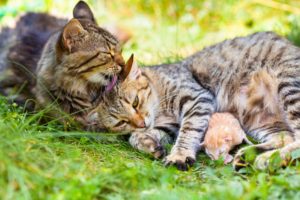 Cats are known to be clean animals and spend a great deal of time grooming themselves. But they will also lick each other, usually already known to one another, or related cats, as a sign of affection or for bonding. This is known as allogrooming. They will also lick humans as a sign of warmth and friendliness.
Cats are known to be clean animals and spend a great deal of time grooming themselves. But they will also lick each other, usually already known to one another, or related cats, as a sign of affection or for bonding. This is known as allogrooming. They will also lick humans as a sign of warmth and friendliness.
Touching noses
Another friendly tactile greeting is touching noses, also known as ‘sniffing noses’.
Kneading or scratching
Cats sometimes knead an object or humans using their front two paws and usually denotes affection and satisfaction. This action will leave the cats own scent – pheromones – from the glands they have on the underside of their paws, on the object they are kneading or scratching.
Head bumping and check rubbing
Cats also have scent glands around their mouth and cheeks therefore head bumping will release the pheromones. These actions are communicating friendliness and affection but sometimes a sign of social dominance.
Biting
Gentle biting can simply mean a playful cat and other affectionate signs such as purring or kneading will accompany the mild biting. Biting that is exhibited with hissing and growling will be a sign of an aggressive, angry cat.
How do cats communicate via scent?
Cats have a very well-developed sense of smell and depend on scent extensively as a form of communication. These specific scents can last a long time and are unique to each cat. There are 3 main methods how a cat will communicate via scent:
- Skin
- Urine and faeces
- Feet
Skin
New-born kittens are blind and rely on scent to communicate with their mother. They will leave their scent on mum so that they can find their way to mum. A mother will identify each of the kittens by their individual scent.
 When a cat grooms, she spreads an individual, unique scent across the whole body. As she brushes against object, or rubs herself against things, that scent is left as a message to other cats. Pheromones are stored in glands in various parts of the body, in the area around the mouth, chin, forehead, cheeks, lower back, tail and paws.
When a cat grooms, she spreads an individual, unique scent across the whole body. As she brushes against object, or rubs herself against things, that scent is left as a message to other cats. Pheromones are stored in glands in various parts of the body, in the area around the mouth, chin, forehead, cheeks, lower back, tail and paws.
As well as grooming, rubbing and head-bumping are all methods and behaviours designed to leave a scent on objects. Nose-bumping and cats rubbing heads together is a sign of trust and friendliness.
It is very common for cats to greet their owners return by pressing their faces against your legs and rubbing their entire bodies around your legs. This greeting of rubbing allows your cat to leave its scent on you. As well as marking you with his scent he is also picking up your scent too. Cats have very sensitive noses and it’s important to them that their companions smell familiar. A cat who rubs against you is exhibiting a sign of liking and affection towards you.
Urine and faeces
Scent in urine and faeces also aid a cat’s communication particularly for marking territory. The scent left can then be interpreted by other cats. This scent alone can communicate to other cats the size, sex and reproductive status of an individual cat.
Feet
Cats also have scent glands on their feet. They will scratch on posts and trees to keep paws in a good condition but also to leave a scent mark. Cats have a tendency to scratch repeatedly in familiar, known spots.
How to communicate with your cat?
Talking and communicating with your cat is potentially easy as relationships between owners and cats are strong. There is a special bond in any relationship between an owner and their cat as it is one of equality and mutual respect not being bound to each other out of duty and need. Here are a few key pointers for communicating effectively with your cat:
Tone and vocal cues
When talking to your cat, the tone of your voice can be a key factor. A light and warm, loving tone will convey praise and affection. It also seems to be that cats seem to prefer higher pitched voices. There is never a reason to shout at your cat but if you need to teach them that a particular behaviour is not acceptable then lower the pitch and tone of your voice. The contrast in the delivery of the message will be much clearer than if words are just delivered in the same tone.
Repetition of words can be effective in communicating a message to your cat, such as “good girl” especially if reinforced with a tasty treat.
Some experts have observed that cats respond better to a higher pitched voice so try using your higher voice – men too!
By being consistent with tone, facial expressions and body language you cat will soon come to understand your language as effectively as you come to learn their own language. And it also goes without saying that the more you communicate with your cat, the better you will both become at understanding each other.
Physical communication
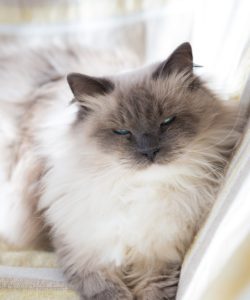 As we discovered above, a slow blink between cats is a sign of calm and a contented cat. When your cat is calm and relaxed, try closing your eyes slowly and then opening them to communicate your calmness and affection towards her. You many even have a slow love blink returned to you.
As we discovered above, a slow blink between cats is a sign of calm and a contented cat. When your cat is calm and relaxed, try closing your eyes slowly and then opening them to communicate your calmness and affection towards her. You many even have a slow love blink returned to you.
Replicate the ‘touching noses’ greeting that cats do by curling your index finger and then, whilst sitting, slowly extend your arm towards your cat. Ensure slow and clear movements. No surprises or sudden movements are key to encouraging your cat to come over and return a friendly greeting.
Quiet time
Cats do enjoy a quiet, calm atmosphere, away from loud noises. Cats have very sensitive hearing, this is key to their hunting skills, but it does mean that noises are amplified. Sudden and loud noises can be particularly frightening for them especially as they are always on alert ready to defend or leap into action if danger or a predator is near.
It can be just as effective and rewarding to communicate just by sitting peacefully together. Let the beauty of the silence and your relaxed positive body language be the communicating factors rather than your vocal cues. Indeed, this can be beneficial to you both.
Stroking your cat
 Stroking your cat releases oxytocin – the feel good hormone which improves your mood and helps you release any stress and tension you are holding in your physical body. We all know the benefit of cuddles, and cuddling your cat is no exception. Aim to stroke your cat every day, if not 2-3 times a day to significantly feel a difference in your physical wellbeing and improve your ability to relax and switch off. Your cat will enjoy a good fuss and stroking too. Pay extra attention to under their chin, behind their ears, rubbing their neck and massaging their cheeks. These spots will have your cat purring with delight.
Stroking your cat releases oxytocin – the feel good hormone which improves your mood and helps you release any stress and tension you are holding in your physical body. We all know the benefit of cuddles, and cuddling your cat is no exception. Aim to stroke your cat every day, if not 2-3 times a day to significantly feel a difference in your physical wellbeing and improve your ability to relax and switch off. Your cat will enjoy a good fuss and stroking too. Pay extra attention to under their chin, behind their ears, rubbing their neck and massaging their cheeks. These spots will have your cat purring with delight.
Listen to your cat purring
Many people love and are drawn to the beautiful sound of cats purring and for good reason. They find cat purring soothing, relaxing and comforting especially when a cat really gets into its musical rhythm. Science has proved that a cat’s purr has a beneficial effect on human health as well as a healing effect on the cat’s own body. A cat purrs at a vibrational rate of 20-140 hertz and as humans when we experience a vibrational rate of 18-35 hertz an hour, science has shown a healing effect on joint mobility, bones, tendons and muscles. The release of endorphins activated by a cats purring has also been found to assist in soothing pain. So next time your cat comes and sits on your lap and starts it’s musical purring enjoy and reap the benefits of its therapeutic abilities for 10-20 minutes. There’s no excuse now to feel guilty about spending time with your cat as it’s truly a healing and scientifically proven beneficial experience.
For an insight into communicating energetically with your cat please see our article ‘The Energetic power of cats and their Spiritual meaning’.
Conclusion
Cat communication is indeed quite complex in that you cannot simply rely on one noise or one posture to understand your cat. We’ve explored the vocalisation, various body postures and unique traits and habits that felines use to express themselves and what they mean. Indeed, cats are very clever, and rather complex animals. We have learnt too that each noise, each quirky mannerism does have a function or a message, be it to another cat or to us, their owners. By quietly observing, learning the key common attributes of how cats communicate then we can indeed begin to understand the messages of our feline friends. And with patience, a little trial and error, and some knowledge from other cat experts and cat owners we can even learn to convey our messages to cats. Have fun, be patient and enjoy getting to know your cat on an even deeper level.
As with any cat issue, if you have any concerns, do not hesitate to seek professional advice from your veterinary.
Other articles you may find of interest:
Why do cats have whiskers? And fun facts about cat’s whiskers!
Why do cats have tails? Do cats like their tails stroked?
Can cats see close up? Can cats see In the dark? Can cats See color?

